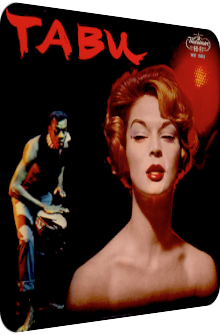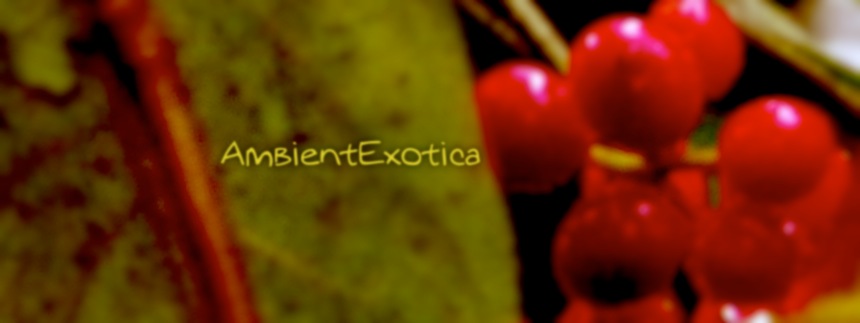
Ralph Font
Tabu
1959
Ralph Font (1913–2005) was a New York-born pianist whose best known Exotica-related work is undoubtedly Tabu, released in 1959 on the – obviously British – Westminster label. Thanks to the large budget and the many pressings, the vinyl version is easy to get. But luckily enough, the good people of the Sinetone label have re-issued Tabu in January 2012 in a remastered digital form, making it even more easily available on iTunes, Amazon MP3 and Co. The original iconic front cover as pictured above has been changed, as it is all too often the case, but it is the music that ultimately counts, and one can change the front artwork of digital files anyway. Tabu is a 12-track album full of Latin tunes. So far, so commonplace. The exotic factor is nonetheless big enough for me to consider a review in the Exotica section.
There are several reasons for this. Firstly, Ralph Font's orchestra consists of roundabout eight to nine people, among them the dedicated percussionists Victor Gonzalez on the bongos, Wifredo Vicente on the conga, Efrain Vaz on the drums and Candi Cortez on the maracas. In addition to these fellows, there are bassist Rudy Richko, guitarist Lydio Fuentes and trumpeter Ariel Durberque. Secondly, the mood is entirely blithesome and amicable, the band members sing and chant, with only one tune being a lamento piece. The good mood causes this work to be compatible to the needs of an Exotica follower even without birdcalls, ukuleles or wind chimes. If that was not enough, there is thirdly the large amount of four percussionists. They provide the doses of dense percussion goodness and rev up the tribal factor. And finally, I shall not forget to mention the sound quality of the album: the recordings sound a bit muffled, the bongos are hence hollow, but this turns out to be a boon an is exactly what the doctor ordered! The octet creates the illusion of a live setup which a pristine stereo album cannot evoke. It is as if a moiré or veil is placed over the album, but this works to its advantage.
Richard Eg's Bodequero – also known as El Bodeguero – opens the LP and sees Ariel Durberque taking the lead with his trumpet and Ralph Font providing the responsive backdrop to the backing choir's "toma chocolate paga lo que debes" vocals. Bandleader Font is then in the limelight thanks to a long piano segue which connects the vocal sections with the trumpet parts. The glitzy Samba Brazilian Willy-Willy is next, and boy, is it upbeat! Gonzalez' bongo aorta is tremendously catchy and closely entangled with Wilfredo Vicente's conga, all the while the trumpet sections are much more warm-hearted this time. Font plays his piano in a jumpy Honky Tonk way with the occasional glissando sections in-between the staccato waves. I stand by my opinion: it is the bongos that make this take so great, nothing else.
The third composition is another treat, as it is composed by Ralph Font himself: Chicharrón enchants with red-tinted piano notes, a clave-infused bongo beat and accompanying trumpet melodies. The Latin flavor is huge but strictly blithesome. Near the end of the song, one of the band members chants Cuban mannerisms and asks the public to join in. His occurence adds much to the effervescence and s(t)imulates the perception of taking part in a bustling event.
It is Luis Alberti's 1955 Merengue Compadre Pedro Juan which is the catchiest tune of side A. The trumpet melody is very hummable, several Baile chants boost the vivacity, and let me not forget to mention the upbeat tempo and Ralph Font's flamboyant piano sprinkles which expand the fun only more, in fact so much so that the stellar bongo accompaniment is outshone for the first time. The gleaming Peanut Vendor by Moises Simons, opens up the instrumental pool by admixing an alto flute next to the trumpet melodies and the aqueous piano droplets. The sun-soaked heat and midday atmosphere is celebratory and quite a bit larger in scope. The surprises do not end here, for a second trumpet player joins; the trumpet-related polyphony is gorgeous, the paradisiacal flute eupeptic, and the bongo layer delicately hollow. A rendition that remains potentially stuck in one's head due to the additional instruments and Simons' indestructible melody.
The sixth song, Margarita Lecuona's eponymous Taboo or Tabu, closes side A. I am usually wary of its doleful tone sequences and therefore hail Les Baxter's transcendent take on his pre-Exotica album Caribbean Moonlight (1956) as the greatest rendition of all times. Ralph Font's try is much more earthen and spreads its Latin rhizomes in the form of Victor Gonzalez' hollow bongo groove, Font's own piano spirals and Ariel Durberque's muted trumpet, the latter of which is incredibly piercing and dirty, causing an incisive counterpart to the surprisingly lofty piano accents. This version feels hot-blooded and yet playful, getting rid of the gloomy atmosphere which is often injected in vintage Exotic versions. The trumpet is a matter of taste, and at least to my mind is played over the top all too often, but there is nothing wrong with this arrangement per se. It evokes the scenery of a far-away bodega bar.
Side B turns into nocturnal climes and launches with Agustín Lara's Noche De Ronda, a song loaded with legato trumpet tones, downwards spiraling piano notes and euphonious counterparts in tercet form. Shuttling between blitheness and lamento sections in minor, the former mood is much more dominant than the gloomy opposition. Pacha Galan's Cosita Linda is a prime example of a Latin tune: an eclectic percussion pattern ennobles the band's almost whispering vocals which are rounded off with Ralph Font's repetitive piano motif. This is one of the tunes that works yet again due to the bongos. While Ernesto Lecuona's La Comparsa changes the timbre and oscillates between a baroque gravity and a heavy mélange of multiple trumpets plus piano accents, Johnny Conquet's Piano Merengue features specifically punchy bongos with a vivid decay, a fast-paced tempo and golden-shimmering piano keys.
This mercurial mood is negated in Consuelo Vel's love-focused Bésame Mucho. The tempo is decidedly reduced, the sustain of the bongos meshes with the pitch-black distance, and sad piano tones as well as mourning violin-resembling (!) trumpet sequences change the color palette into hatched tones. This is the weakest track of the whole LP, devoid of any traces of happiness. The glee returns in the Latin outro El Botellero, originally written by Gilberto Valdés. Not only is it the thematical foil to Peanut Vendor, it furthermore encapsulates sun-dried piano chords and lofty flutes in adjacency to brightly lit polyphonous brass bursts and a laid-back bongo thicket. The album ends in a frolicking way.
Bésame Mucho remains the only instance where typical Latin mourning phases are unleashed. Each of the other tunes is mostly iridescent and amicable, depicting infusions of the Brazilian way of life and the Cuban spirit of fiestas in a balanced way, i.e. occasionally stereotyped but mostly faithful. The biggest and most successful stylistic particularity of this album is based on the recording equipment. The instruments sound quite a bit muffled – even in the remastered re-issue – and eminently blurry, the bongos are overly hollow with larger amounts of reverb, but this is exactly what elevates this LP from the pitch-perfect audiophile material in the veins of Enoch Light's Spanish Strings (1966). The variety is also a big plus, and the focus on the bongos turns out to be a boon. All these ingredients make Tabu a splendid Latin album that outshines Stanley Black's Cuban Moonlight by a galactic margin.
The album has that dynamic feeling of being played live, and the amount of percussionists and band members in general only adds to the densely layered atmosphere, a trick which still works to this day as Ìxtahuele's 2012 debut EP The Exotic Sounds Of Ìxtahuele impressingly shows. It shares the same features with Ralph Font's album, but sounds totally different since it is a proper neo-Exotica artifact. Three dedicated percussionists are reserved for the eclectic patterns, and the hollowness of the bongos causes a live feeling that is unbeatable. There is a reason why Ralph Font's Tabu is his most famous work in Exotica circles. The percussion is electrifying, the many instruments and textures turn out to interpolate the diversity, and even though this is a boldly Latin album, fans of Polynesian music should definitely investigate, if only for the ubiquity of the bongos and congas. The album is available on vinyl and as a digital download on iTunes and Amazon MP3. There are many worse Retro Latin albums out there, so start your engines.
Exotica Review 178: Ralph Font – Tabu (1959). Originally published on Feb. 9, 2013 at AmbientExotica.com.
